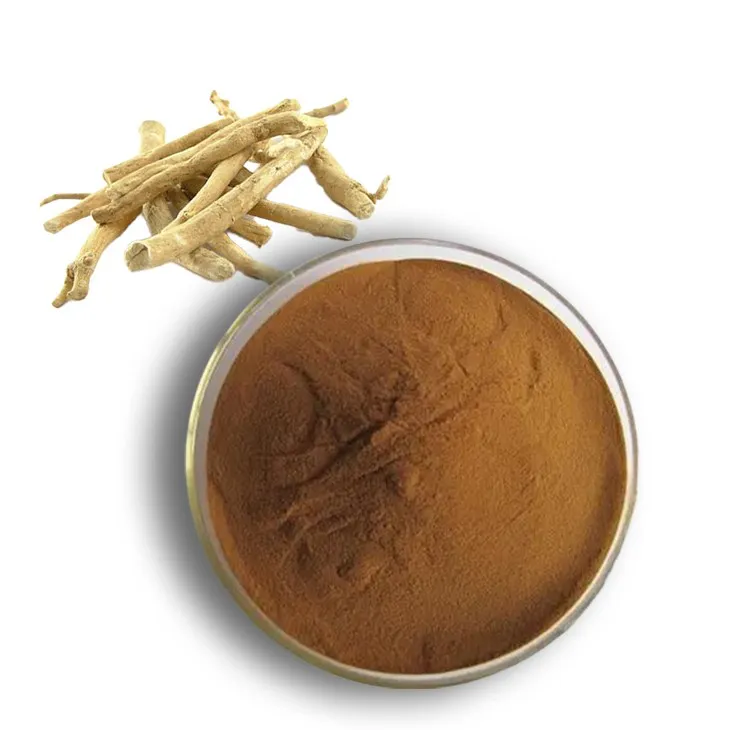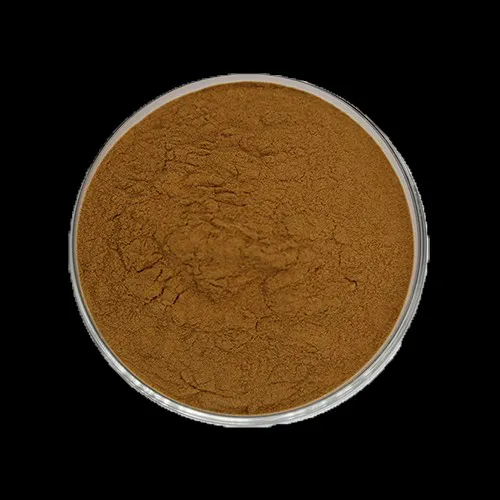- 0086-571-85302990
- sales@greenskybio.com
Mature Withania somnifera flavor and natural Withania somnifera extract.
2024-11-11

1. Introduction to Ashwagandha
Ashwagandha, scientifically known as Withania somnifera, is a remarkable plant that has been used in traditional medicine systems for centuries. Originating from India, it has now gained global recognition for its various health - promoting properties. This plant belongs to the Solanaceae family and is often referred to as "Indian ginseng" due to its similar adaptogenic properties as Panax ginseng.

2. The Mature Flavor of Ashwagandha
2.1 Factors Affecting the Flavor
The mature flavor of Ashwagandha can be significantly influenced by multiple factors. Growing conditions play a crucial role. For instance, the soil type, whether it is rich in nutrients or lacking certain minerals, can impact the flavor profile. If the soil is well - drained and fertile, it may contribute to a more complex and pleasant flavor. Climate also matters. Ashwagandha plants grown in regions with a warm and dry climate may develop different flavors compared to those in cooler and more humid areas.
Another important factor is the harvesting time. Harvesting at the right time is essential to capture the optimal flavor. If it is harvested too early, the flavor may be underdeveloped, lacking the depth and complexity that comes with maturity. On the other hand, if it is harvested too late, the flavor may become overly strong or even bitter.
2.2 Sensory Experience of the Flavor
The flavor of mature Ashwagandha is a unique sensory experience. It has a somewhat earthy and slightly bitter taste, which is often accompanied by a hint of sweetness. This complex flavor profile can be compared to a fine wine, where different tasting notes come together to create a distinct and alluring experience. When consumed, the initial earthy note gives a sense of grounding, followed by the gentle bitterness that adds depth, and finally, the subtle sweetness that rounds out the flavor.

3. Natural Ashwagandha Extract
3.1 Nutrients and Phytochemicals
The natural Ashwagandha extract is a rich source of various nutrients and phytochemicals. It contains important vitamins such as vitamin C, which is essential for the immune system, and vitamin E, an antioxidant that helps protect cells from damage. Minerals like potassium, which is crucial for heart health, are also present in the extract.
In terms of phytochemicals, Ashwagandha extract is loaded with withanolides. These are steroidal lactones that are believed to be responsible for many of the plant's health - promoting effects. Withanolides have anti - inflammatory properties, which can help reduce inflammation in the body. They also have adaptogenic properties, enabling the body to better cope with stress.
3.2 Extraction Methods
There are several methods for extracting Ashwagandha. One common method is solvent extraction. In this process, a suitable solvent, such as ethanol or water, is used to extract the active compounds from the plant material. Ethanol extraction is often preferred as it can extract a wide range of compounds, including the withanolides. Another method is supercritical fluid extraction, which uses supercritical carbon dioxide as the solvent. This method is considered more environmentally friendly and can produce a high - quality extract with a relatively pure composition.

4. Relationship between the Flavor and the Extract
The flavor of Ashwagandha and its natural extract are closely related. The compounds that contribute to the flavor are often also part of the extract's chemical composition. For example, some of the phytochemicals that give Ashwagandha its unique flavor may also be responsible for its health - promoting properties. The extraction process can influence the flavor of the final product. If the extraction is not carried out properly, it may lead to a loss of certain flavor - related compounds, resulting in a less desirable flavor in the extract.

5. Significance in Promoting Well - being
5.1 Health Benefits
Both the mature flavor and the natural extract of Ashwagandha have significant implications for health. The adaptogenic properties of Ashwagandha, due to the presence of withanolides in the extract, can help the body adapt to stress more effectively. This can lead to reduced levels of stress hormones such as cortisol, which in turn can improve overall mental well - being.
In addition, the anti - inflammatory properties of the extract can be beneficial for various health conditions. It may help in alleviating symptoms of arthritis, reducing inflammation in the joints and improving mobility. The nutrients present in the extract, such as vitamins and minerals, also contribute to maintaining good health. For example, the potassium in Ashwagandha can help regulate blood pressure.
5.2 Role in Food and Beverages
In the food and beverage industry, the mature flavor of Ashwagandha can be used to add a unique and healthy touch. It can be incorporated into herbal teas, where its earthy and slightly bitter flavor can create a complex and interesting taste profile. In some functional foods, such as energy bars or smoothies, Ashwagandha extract can be added for its health - promoting properties. The addition of Ashwagandha can also attract consumers who are looking for natural and healthy ingredients in their food and drinks.
5.3 Use in Cosmetics
In the cosmetics field, Ashwagandha extract is gaining popularity. The anti - inflammatory and antioxidant properties of the extract make it suitable for skin care products. It can be used in creams and lotions to help reduce skin inflammation, protect against oxidative stress, and improve skin elasticity. The extract may also have potential benefits for hair health, as it can nourish the hair follicles and promote stronger, healthier hair growth.
6. Current and Future Applications
6.1 Current Usage in Health Products
Currently, Ashwagandha extract is widely used in various health products. It can be found in dietary supplements in the form of capsules or tablets. These supplements are often marketed for stress management, energy boost, and overall well - being. Some herbal remedies also use Ashwagandha as a key ingredient for treating various ailments, such as insomnia or mild anxiety.
6.2 Future Trends in the Food, Health, and Cosmetics Industries
In the future, we can expect to see more innovative applications of Ashwagandha in the food, health, and cosmetics industries. In the food industry, there may be more Ashwagandha - infused products, such as flavored waters or snack bars. In the health sector, research may lead to the development of more targeted Ashwagandha - based supplements for specific health conditions. In cosmetics, new formulations may be created to maximize the benefits of Ashwagandha extract for skin and hair health.
7. Conclusion
The mature flavor of Ashwagandha and its natural extract are two fascinating aspects of this ancient plant. The flavor offers a unique sensory experience, while the extract is a treasure trove of nutrients and phytochemicals. Their relationship is intertwined, and both play important roles in promoting well - being in various fields, including health, food, and cosmetics. As research continues and our understanding of Ashwagandha deepens, we can look forward to more exciting applications and discoveries related to this remarkable plant.
FAQ:
What are the main factors influencing the mature flavor of Ashwagandha?
The main factors influencing the mature flavor of Ashwagandha include growing conditions such as soil type, climate, and sunlight exposure. Additionally, the harvesting time also plays a crucial role. If it is harvested too early or too late, it can significantly affect the flavor profile. Different regions may also produce Ashwagandha with slightly different flavors due to variations in these factors.
What nutrients and phytochemicals are typically found in natural Ashwagandha extract?
Natural Ashwagandha extract contains a variety of nutrients and phytochemicals. It is rich in withanolides, which are steroidal lactones. It also contains alkaloids, flavonoids, and sitoindosides. These components are believed to contribute to its various health - promoting properties, such as reducing stress, enhancing immunity, and improving cognitive function.
How is the mature flavor of Ashwagandha related to its natural extract?
The mature flavor of Ashwagandha can be an indicator of the quality and composition of its natural extract. The compounds that give Ashwagandha its unique flavor are often related to the phytochemicals present in the extract. For example, the presence of certain withanolides may contribute to both the flavor and the medicinal properties of the extract. Moreover, the flavor can also be affected by the extraction process, which in turn can influence the concentration and bioavailability of the nutrients and phytochemicals in the extract.
How is Ashwagandha used in the food industry?
In the food industry, Ashwagandha can be used in several ways. Its mature flavor can be incorporated into functional foods, such as energy bars or herbal teas, to add a unique taste. The natural extract can also be added to food products for its potential health benefits. For example, it can be used in smoothies or health - conscious snacks. However, regulations regarding the use of Ashwagandha in food vary by region, and proper labeling is necessary to inform consumers about its presence and potential effects.
How does Ashwagandha promote well - being?
Ashwagandha promotes well - being through multiple mechanisms. Its natural extract, with its rich content of withanolides and other phytochemicals, has been shown to help the body adapt to stress, thereby reducing stress - related symptoms. It may also enhance the immune system, improve cognitive function, and support healthy sleep patterns. The antioxidant properties of the phytochemicals in Ashwagandha can also protect cells from damage caused by free radicals, contributing to overall health and well - being.
Related literature
- The Chemical Composition and Medicinal Properties of Ashwagandha"
- "Ashwagandha: From Traditional Use to Modern Applications"
- "Flavor Profiles and Phytochemical Content of Mature Ashwagandha"
- ▶ Hesperidin
- ▶ citrus bioflavonoids
- ▶ plant extract
- ▶ lycopene
- ▶ Diosmin
- ▶ Grape seed extract
- ▶ Sea buckthorn Juice Powder
- ▶ Beetroot powder
- ▶ Hops Extract
- ▶ Artichoke Extract
- ▶ Reishi mushroom extract
- ▶ Astaxanthin
- ▶ Green Tea Extract
- ▶ Curcumin Extract
- ▶ Horse Chestnut Extract
- ▶ Other Problems
- ▶ Boswellia Serrata Extract
- ▶ Resveratrol Extract
- ▶ Marigold Extract
- ▶ Grape Leaf Extract
- ▶ blog3
-
Cranberry Plants and Skin - care Products.
2024-11-11
-
Cactus Extract
2024-11-11
-
Grape Leaf Extract
2024-11-11
-
Sophora Japonica Flower Extract
2024-11-11
-
Ivy Extract
2024-11-11
-
Maca Extract
2024-11-11
-
Eyebright Extract
2024-11-11
-
Cat Claw Extract
2024-11-11
-
Andrographis Paniculata Extract Powder
2024-11-11
-
Curcumin Extract
2024-11-11
-
Gynostemma pentaphyllum extract
2024-11-11





















